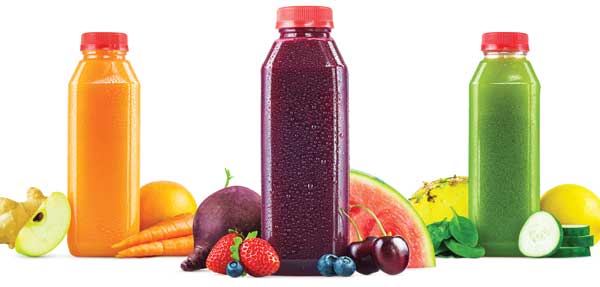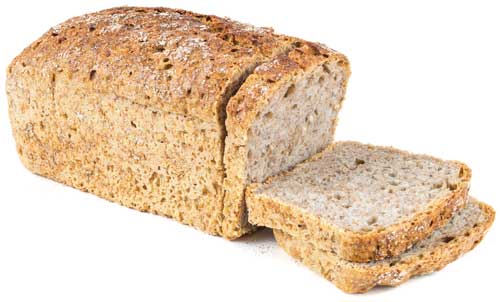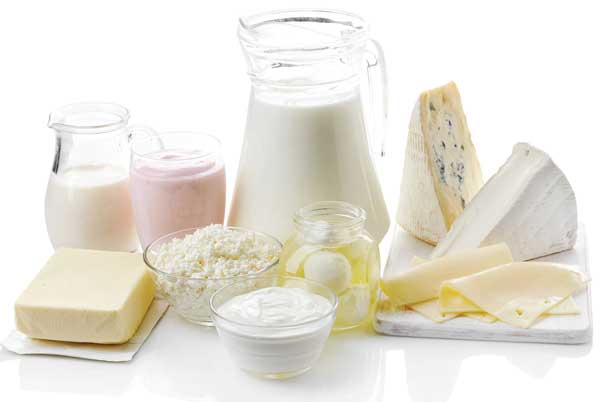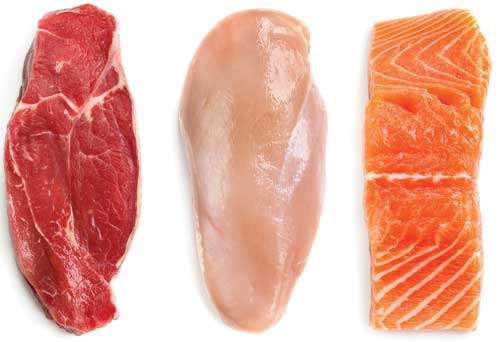Enzymes Keep the Process Moving
INGREDIENTS

Take any food product and chances are that it contains at least one ingredient made from an enzyme. These unsung stars of food and beverage processing play important and diversified roles in the processing conditions (as catalysts that speed up chemical reactions) and characteristics and functions of the final product, and they go unnoticed by consumers. (Since enzymes do not function in the finished product, they are considered processing aids, not food additives, and therefore are not required to be labeled on ingredient lists.)
 Enzymes are used in modern food processing, and their use goes back to ancient times, though it wasn’t until the late 19th century that the importance of enzymes was recognized, and valuable discoveries made. One such discovery involved the Danish chemist Christian Hansen, who conducted research on rennet derived from the stomach of ruminants and looked for ways to produce it on a factory-scale level. Today, food manufacturers can choose from numerous specially designed enzymes and enzyme blends to improve the texture of bread, add flavors to cheese, and clarify vegetable juices, to name just a few functions. Additionally, enzyme suppliers can work with product developers to pinpoint an exact formulation challenge and deliver an enzyme or combination of enzymes that address it.
Enzymes are used in modern food processing, and their use goes back to ancient times, though it wasn’t until the late 19th century that the importance of enzymes was recognized, and valuable discoveries made. One such discovery involved the Danish chemist Christian Hansen, who conducted research on rennet derived from the stomach of ruminants and looked for ways to produce it on a factory-scale level. Today, food manufacturers can choose from numerous specially designed enzymes and enzyme blends to improve the texture of bread, add flavors to cheese, and clarify vegetable juices, to name just a few functions. Additionally, enzyme suppliers can work with product developers to pinpoint an exact formulation challenge and deliver an enzyme or combination of enzymes that address it.
 Improving Bakery Products
Improving Bakery Products
Commercial bakers face many process challenges that affect both the dough and the finished product. As far as the dough is concerned, bakers may find that it is too sticky, has a weak structure, or has reduced elasticity. Bread may harden too quickly, cakes have poor crumb structure, and crackers develop a tough texture. Amylases, xylanases, and proteases help overcome these problems, improving process optimization and product quality.
VERON baking enzymes from AB Enzymes are specially formulated to address specific functional challenges in the various baking applications. Xylanases convert insoluble hemicellulose in dough into soluble hemicellulose, which has a major impact on the gas retention capacity of wheat dough. It does this by supporting the formation of the gluten network and stabilizing the gluten structure. AB Enzymes’ VERON xylanases produce a stable, fluffy bread dough and loaves that have good volume and a soft and elastic crumb.
Another enzyme used in baking is amylase, which plays a role in dough fermentation. Here, amylases hydrolyze starch to create sugars that yeast use during fermentation, and they may also improve dough processing, baking volume, and crust browning, according to the company. Some of AB Enzymes’ amylases act in a synergistic effect with xylanases to improve dough and the finished product. VERON M4 concentrated fungal alpha-amylase, a microbially produced amylase, regulates gassing and speeds up fermentation properties. Also, it can be used to adjust the natural variations in flour, which contains varying amounts of amylase that differs between regions and between crops, to result in consistent baking results, according to the company.
Sometimes a baker may use a flour with a high protein content or want a level of dough relaxation to meet a specific purpose. AB Enzymes’ proteases either specifically target the gluten network to achieve a controllable degree of relaxation without destroying the protein network and losing its gas-holding capacity or broadly target the gluten network for a strong relaxation effect. When a flour with a low protein content is used or general dough stabilization is desired, the company suggests using special dough-strengthening enzymes, transglutaminases. These enzymes stabilize the dough’s protein matrix in one of two ways. They either cross link the gluten network with covalent molecular bonds to produce a stable dough or they increase the oxidation of disulfide groups in the dough’s protein network. VERON TG is a strong protein cross-linking enzyme that increases the elasticity of dough and increases fermentation tolerance.
The gluten-free trend continues to draw interest from certain consumer segments, and it has caused bakers to completely rethink common bakery formulations and the ingredients used in them. As any baker knows, the texture of bakery products is negatively affected when gluten is removed, and it can take a lot of trial and error to formulate gluten-free bakery products with acceptable texture that is as close to its conventional counterpart as possible.
Almost two-thirds (63%) of U.S. consumers say the moistness and softness of gluten-free bread needs improvement, according to a survey conducted by DSM (DSM 2017). Ingredient suppliers offer everything from hydrocolloid systems to emulsifiers, and even enzymes, to improve processing and sensory qualities of gluten-free bakery products. Last year, DSM launched a series of enzymes under the Bakezyme brand designed to improve the softness and moistness of gluten-free bread. Bakers can choose from an amylase, protease, amyloglucosidase, xylanase, and glucose oxidase, as well as five different enzyme blends.
SternEnzym presented several enzyme systems to improve bakery products and pasta at the Food Ingredients Europe 2017 (FiE 2017). Sternzym BK improves the processability of doughs, enhances the structure of biscuits, and reduces the tendency toward cracking and blistering, while Sternzym LQ enhances the appearance of wafers and their mechanical stability. There’s also an enzyme ingredient to improve pasta. Pastazym can be used in pasta products made from hard wheat or soft wheat, giving the products a better tolerance to prolonged cooking times. The enzyme increases the mechanical stability of dried noodles. In addition to these enzymes that improve bakery products and pasta, SternEnzym offers one that prevents the formation of acrylamide in French fries, pastry products, and bread. DeutscheBack, another enzyme manufacturer that exhibited at FiE 2017, showcased TopSweet Fresh Cake and TopBake Fresh enzyme systems for pastry products and bread and rolls, respectively. The ingredients prolong the shelf life of the crumb and produce a moister product. The company’s Saltase enzyme system maintains the stability and machinability of dough in salt-reduced formulations.
At another international food show, DuPont Nutrition & Health showcased some new bakery enzymes for the Southeast Asia market. The company presented enzymes from its POWERBake and POWERFresh series at the Food Ingredients Asia 2017 (FiA 2017). In general, the POWERBake enzymes improve flour and bread performance. There is a lipase that improves dough stability, increases volume, and improves dough handling; a bacterial xylanase that strengthens dough; and a cellulase that improves dough proofing stability and improves the overall bread quality. The company in February introduced enzymes from the POWERBake 6000 range to the North American market at the ASB Baking Tech 2018 event. The POWERFresh enzymes are amylases that lower the rate of amylopectin retrogradation, slowing the bread staling process.
 CHO-Modifying Enzymes for Sugar Reduction
CHO-Modifying Enzymes for Sugar Reduction
In addition to their functions such as catalyzing a reaction that develops aroma profiles in wine and breaking down pectin in fruit juice processing, enzymes also help developers produce foods that meet two specific food trends.
Sugar reduction and fiber inclusion are top-of-mind product development issues for food manufacturers. Recognizing that these can be major reformulation efforts for food manufacturers, Biocatalysts recently unveiled a range of carbohydrate-modifying enzymes developed specifically for manufacturers who want to reduce added sugars in products or enrich products with fiber. The range of enzymes, which the company called an enzyme panel, was on display at the FiE 2017 show. It consisted of various small samples of enzymes that have been discovered to be specifically active on carbohydrates such as pectin, xylan, and mannan, allowing them to add specific value to various types of food applications. The company notes that some of the functions of its carbohydrate-modifying enzymes include building polymers and oligosaccharides from simple monomeric and dimeric sugars or reducing large complex carbohydrate polymers to smaller oligosaccharides for use as soluble fiber or bulking agents.
 Improve Cheese with Enzymes
Improve Cheese with Enzymes
Enzymes are essential ingredients in the dairy products industry where they help to improve low cheese yield, enhance texture, taste, and flavor, and produce lactose-free products, among other functions. Lactase, for example, converts lactose to digestible sugars and is formulated into lactose-free dairy products, while rennet, an enzyme mixture derived from the stomachs of ruminant animals, facilitates the separation of curd from whey when making cheese. Cheese manufacturing is an area in which the source of the enzyme and the specific functions it provides are carefully considered.
“For certain applications there are definitely enzymes from particular sources that are evaluated by product developers more often than others,” says Christina Barsa, technical sales representative at Enzyme Development Corp. “Product developers usually start their work on an application with enzymes that were used in published research of that application.”
Cheese production is a good example of an application where some enzymes tend to be used over others, she says. “Typically, animal enzymes, fermentation-produced chymosin, and lipases from A. niger or Mucor javonicus are used in cheese. Lipases and proteases for Rhizopus and yeast sources can also be used for flavor development in cheese, but they are less commonly applied in these products. Enzymes from Rhizopus and yeast sources are often found in specialty cheeses and flavoring applications.”
Barsa mentions another not-so-common enzyme in cheese production, this one a protease from the cardoon flower, a type of purple thistle (the enzyme is often referred to as thistle rennet). The enzyme has been used to make Spanish and Portuguese cheeses for more than 2,000 years. In the United States, though, you will only find cheese made with thistle rennet in high-priced specialty cheese shops, says Barsa. “The lipases and proteases for Rhizopus and the thistle protease not only work in cheese application, they will also work in other applications for lipid and protein hydrolysis. However, having not been historically used in these applications, they are usually not a product developer’s first choice when it comes to evaluating enzymes.”
Enzyme Development Corp.’s thistle rennet ingredient is called Cynzime. It is a 100% plant extract (from the so-called thistle flower, Cynara cardunculus) that is available in both liquid and powder forms. The enzyme ingredient is standardized to provide consistent milk clotting activity in milk from cows, buffalos, goats, sheep, and camels and to eliminate the variations that come from using the flowers of the cardoon plant, according to the company. It clots or hydrolyzes alpha, beta, kappa, and gamma caseins, whereas microbial-derived rennet tends to clot only kappa casein.
Other types of enzymes help cheese manufacturers create flavors and textures that differentiate their cheeses from others. Chr. Hansen’s SPICEIT lipases accelerate the development of sharp and piquant flavors in cheese by breaking down milk fat triglycerides to fatty acids. Maxiren XDS from DSM is a bovine chymosin that maintains cheese texture over shelf life, especially in mozzarella, string cheese, and Cheddar, by slowing the proteolytic activity of the cheese. The company’s Suparen microbial coagulant has high thermolability and is for use in Swiss cheeses and hard cheeses like Parmesan and pecorino. Piccantase, also from DSM, is a range of lipases, some of which are derived from animals, and others are produced using a fermentation method. These ripening enzymes help develop the flavors in various Italian cheeses, blue cheese, feta cheese, and enzyme-modified cheese. Accelerzyme is a range of proteases and peptidases that increase ripening times and optimize taste characteristics in all types of natural ripened cheeses and enzyme-modified cheese.
Next month’s Ingredients section will provide details about meat and seafood ingredients and ingredients used to formulate meat and seafood products.
Where Enzymes are Derived
Enzymes used in the food industry come from animal, botanical, and microbial sources. Enzymes derived from animal sources are typically used in cheese making, specifically proteases from calf, goat, or sheep stomachs, which are used as rennet, explains Christina Barsa, technical sales representative at Enzyme Development Corp., which supplies enzymes from botanical and microbial sources. Lipases, which also come from these animals’ stomachs, are used for flavor development.
 As far as enzymes from botanical sources are concerned, the two most commonly used ones are papain, a protease from the dried latex of the fruit of Carica papaya, and bromelain, a protease extracted from the mature pineapple plant stems of the Bromeliceae family, says Barsa. Both papain and bromelain are active components of meat tenderizers. “Ficin, a protease from the latex of fig trees, was also used for this purpose until a few years ago. However, a global shortage of fig tree latex has forced product developers to reformulate their products with other proteases, such as papain and bromelain.”
As far as enzymes from botanical sources are concerned, the two most commonly used ones are papain, a protease from the dried latex of the fruit of Carica papaya, and bromelain, a protease extracted from the mature pineapple plant stems of the Bromeliceae family, says Barsa. Both papain and bromelain are active components of meat tenderizers. “Ficin, a protease from the latex of fig trees, was also used for this purpose until a few years ago. However, a global shortage of fig tree latex has forced product developers to reformulate their products with other proteases, such as papain and bromelain.”
Enzyme Development Corp. is the only producer of papain in the Western Hemisphere, says Barsa. The company offers four different papain brands. Enzeco Purified Papain is a high activity powder while Panol is a standardized lower activity powder that is ideal for applications like meat tenderizing. Liquipanol is a liquid papain. Enzeco Purified Papain RS is a no-sulfite-added papain that is generally less than 10 ppm sulfites.
Finally, enzymes can be derived from microbial sources. This is through microbial fermentation, and the sources can be from bacteria, fungi, or yeasts. Some of the common microorganisms used to produce enzymes for food production are Bacillus coagulans, Aspergillus niger, and Saccharomyces cerevisiae. “The reason you would choose an enzyme from one source over another is going to depend on the application and the product you are trying to produce,” says Barsa. “Enzymes from different source organisms may work on the same substrate, but the enzymes may also work at different pH and temperature ranges, and the way they cleave that substrate will be different.” She adds that the company produces a variety of fungal and bacterial proteases for use in applications with different pH and temperature ranges. “Proteases are used to increase protein functionality and create high protein content in food products, like protein shakes. Proteases cleave the protein, increasing its solubility, reducing viscosity, and potentially improving the flavor of the proteins. Other new enzymes we have include a β-fructofuranosidase for FOS production, a β-1,3-glucanase for yeast cell wall hydrolysis, and an invertase from a fungal source rather than yeast with greater heat stability and the ability to work at low pH level. This invertase is ideal for making candy with natural red colors, as well as for added sweetness and softness in bakery products.”
New Software Pinpoints Novel Enzymes
Enzyme manufacturer Biocatalysts and The European Bioinformatics Institute, a publicly funded intergovernmental research institute and data provider, developed a software program for data analysis, specifically for identifying novel enzymes rapidly from large metagenomic DNA sequence libraries. The software, MetXtra, allows scientists at Biocatalysts to screen metagenomic libraries for enzymes in minutes rather than days. Here is how the program can pinpoint specific enzymes for an application. MetXtra uses algorithms built upon customer specifications and requirements such as pH, solubility, and temperature. The program then searches through the database of potential enzymes to generate a final list of potential enzymes targeted to the specific needs of the customer.
www.ift.org
Members Only: Read more about enzymes at ift.org. Type the keywords into the search box at the upper right side of the home page.
 Karen Nachay,
Karen Nachay,Senior Associate Editor
[email protected]
References
DSM. 2017. Global Baking Insights: Gluten-Free Bread Consumption. DSM, Delft, the Netherlands. dsm.com/food.
